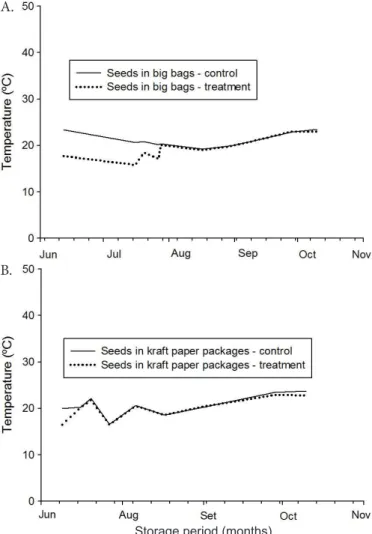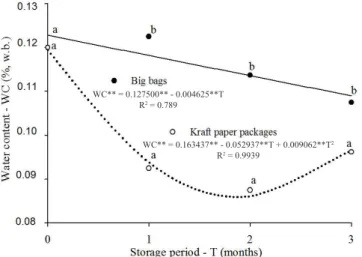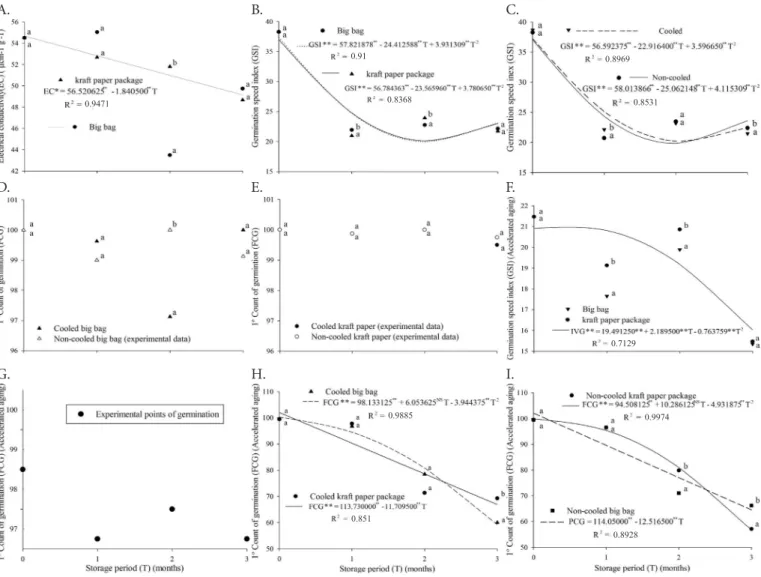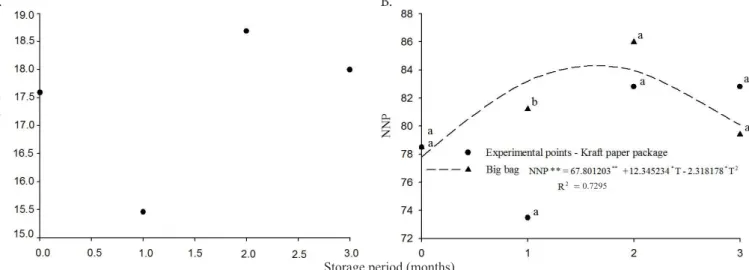Revista Brasileira de
Engenharia Agrícola e Ambiental
Campina Grande, PB, UAEA/UFCG – http://www.agriambi.com.br
v.20, n.5, p.473-480, 2016
Physiological quality of soybean seeds artificially cooled
and stored in different packages
Zirvaldo Z. Virgolino
1, Osvaldo Resende
1, Douglas N. Gonçalves
1,
Kaique A. F. Marçal
1& Juliana de F. Sales
1DOI: http://dx.doi.org/10.1590/1807-1929/agriambi.v20n5p473-480
A B S T R A C T
The aeration of seeds with artificially cooled air and their storage in big-bag packages aim to lengthen the shelf life while maintaining the quality. Thus, the objective was to study the effects of cooling before storage on germination and vigor of soybean seeds stored in trifoliate kraft paper bag and big bag in non-air-conditioned environment. Seeds of soybean cultivar NA 7337 RR were mechanically harvested in March 2013, holding an average moisture content of 18% w.b. In June, 16,000 kg of seeds were processed and cooled to 18 °C. Equal amount of non-cooled seeds was used as a control. Equally divided in kraft paper and in big bags, and combining cooling and packaging, the seeds were stored for three months and analyzed for moisture content, germination and vigor. Cooling to room temperature and different packaging types had similar effects on seed quality. Big bags packing showed better efficiency in retaining the moisture content of cooled seeds. No direct effects of cooling could be identified prior to storage on the germination and vigor of soybean seeds.
Qualidade fisiológica de sementes de soja resfriadas
artificialmente e armazenadas em diferentes embalagens
R E S U M O
A aeração de sementes com ar artificialmente resfriado e o armazenamento em embalagens do tipo ‘big bags’, podem proporcionar melhor manutenção da qualidade fisiológica. Assim, objetivou-se avaliar a qualidade fisiológica de sementes de soja resfriadas artificialmente e armazenadas em diferentes embalagens em ambiente não climatizado. Sementes de soja, cultivar NA 7337 RR, foram colhidas mecanicamente em março de 2013, com teor de água médio de 18% (b.u.). Em junho 16.000 kg de sementes foram beneficiados e resfriados até 18 ºC. Quantidade semelhante de sementes não resfriadas foi utilizada como controle. Divididas em embalagens de papel ‘kraft’ e em ‘big bags’ combinando resfriamento e embalagem, as sementes foram armazenadas por três meses e analisadas quanto ao teor de água, germinação e vigor. O resfriamento e a temperatura ambiente e os tipos diferentes de embalagem tiveram efeitos semelhantes na qualidade fisiológica das sementes. As embalagens ‘big bags’ foram mais eficientes na manutenção do teor de água das sementes resfriadas. Não foram identificados efeitos diretos do resfriamento na germinação nem no vigor das sementes de soja, antes do armazenamento.
Key words:
storage temperature moisture content vigor
germination
Palavras-chave:
armazenamento temperatura teor de água vigor germinação
1 Instituto Federal Goiano/Diretoria de Pesquisa e Pós-Graduação. Rio Verde, GO. E-mail: zvirgolino@yahoo.com.br (Corresponding author);
osvaldo.resende@ifgoiano.edu.br; douglaslng@hotmail.com; kaiqueafmarcal@yahoo.com.br; julianacefetrv@yahoo.com.br
Introduction
The storage of soybean seeds in tropical and subtropical environments is the most difficult stage of the production chain (Minuzzi et al., 2010). Since its beginning, still in the plant, when the seed reaches its physiological maturity point, according to Silva et al. (2010), until the end, at planting, the storing conditions are adverse because of the predominant high temperatures and variable relative humidity.
Alves et al. (2006) highlights that storage is an ecosystem that comprises different competitive factors for the loss of quality of grains and seeds. On the other hand, Demito & Afonso (2009) claim that the physiological and sanitary quality of soybean seeds can be maintained for long periods, if they are maintained under controlled conditions of temperature, relative air humidity and moisture content.
Aeration with artificially cooled air allows reaching the previously mentioned conditions. It reduces and maintains the temperature of stored grains and seeds, besides minimizing the migration of moisture and the process of deterioration (Lopes et al., 2010). Rigueira et al. (2009) claim that the cooling process is an efficient and economic technique to maintain the quality of the product. Its efficiency in the control of pest, insects and pathogens has been demonstrated (Lazzari et al., 2006; Quirino et al., 2013).
Another important aspect in the storage is the type of package, which may have influence on physiological quality of seed (Corlett et al., 2007). Depending on the porosity of the material they are made of and on allowing, to a greater or lesser degree, the exchange of gas and water vapor between the seed and the environment, the packages can be permeable, semipermeable and impermeable (Labbé, 2003).
This study aimed to evaluate the physiological quality of soybean seeds artificially cooled and stored in different packages, in natural environment, along three monthly periods of storage.
Material and Methods
The experiment was conducted at the storing unit of the company Sementes São Francisco, at 970 m of altitude, located in the rural area of the municipality of Rio Verde, at the coordinates of 17º 29’ 36.73’’ S and 51º 36’ 6.19’’ W.
Soybean seeds of the cultivar NA 7337 RR, with medium cycle, mechanically harvested in March 2013, were used in the experiment. After harvest, with mean moisture content of 18% w.b., the seeds were subjected to a pre-cleaning in air machine and sieves for the removal of larger particles; then, they were pre-classified in sieves with 8-mm mesh (circular holes) and 4.75-mm mesh (oblong holes). Drying was performed in cross-flow dryer (KW 60), with maximum temperature of the drying air of 33 ºC until reaching moisture content of 13.5% w.b.
After the pre-processing and drying, the seeds were subjected to a post-cleaning process, also in air machines and sieves, in order to separate impurities from the drying, and temporarily stored in flat-bottom metallic silos with capacity for 4,200 t. In order to maintain the temperature around 20 ºC, the seeds were aerated from the beginning until the
total filling of the silo, i.e., from March through June 2013, when they started to be removed and taken to the processing system. Seed temperature was monitored by the thermometry system of the silo.
At the Seed Processing Unit (SPU), seeds were again cleaned and separated by size, specific mass and shape, completing the processing. In the next step, seeds were cooled in bulk, in concrete boxes with capacity for 120 t until the mean temperature of 18 ºC, using a cooler (Cool Seed, model PC 40).
The treatments consisted in the evaluation of seeds in two conditions of temperature (cooled and non-cooled) and two conditions of packaging (kraft paper package and big bags) during three months of storage.
A lot of 8,000 kg of seeds was stored in packages made of trifoliate kraft paper, with mass of 40 kg, arranged in piles of 50 volumes; another lot of 8,000 kg, cooled, was stored in big bags with capacity for 1,000 kg and arranged on pallets at the floor level. In the same lot, an equal amount of non-cooled seeds was used as a control and stored in big bags and trifoliate kraft paper and only then piled, following the same arrangement used for cooled seeds.
The zero storage period corresponded to the removal of the first non-cooled seed sample, at the moment that they were packed. The storage of seeds continued for three months and the samples were taken monthly.
The seeds were stocked in warehouse without natural lighting and ventilation, with dimensions of 115 x 30 m, ceiling height of 6.70 m, arched metallic roof, without thermal isolation, with arrow of 5.5 m; the walls were made of smooth, exposed ceramic bricks, with 15 cm of width and concrete floor.
The temperature of cooled and non-cooled seed lots during the storage period was initially measured every week and then, with the stabilization at the room temperature, the readings were performed every two weeks.
The temperature in the big bags was monitored at three depths (bottom, middle and top) with five measurements per depth. The piles, with 10 layers of five kraft paper packages, were divided into three pairs of layers (two at the bottom, two in the middle and two on top) and five measurements taken per pair on each side of the pile. Temperature was measured using skewer thermometers with stainless steel rod and precision of one decimal place.
Temperature and relative air humidity in the storing environments were daily monitored using a digital thermo-hygrometer (Novus®, model Logbox-RHT-LCD), programmed to store data every 20 min.
The samples of cooled and non-cooled seeds were subjected to the tests of germination and vigor. The analyses of germination, first count of germination, accelerated aging and emergence in sand were performed according to Brasil (2009). The germination speed index (GSI) was determined according to Maguire (1962).
The moisture content was determined through gravimetry using an oven at 105 ºC for 24 h (Brasil, 2009). The electrical conductivity was determined according to the methodology described by Vieira & Krzyzanowski (1999).
Normal plantlets: Plantlets with the following characte-ristics were evaluated: all the structures intact; long primary root with at least 3 cm and formation of secondary roots; length equal to or higher than 5 cm; elongated hypocotyl and epicotyl and presence of two cotyledons (Nakagawa, 1999).
Number of normal plantlets: Plantlets germinated with length of 1 cm or more were separated and counted, in each sub-replicate, five and eight days after sowing, with all the structures intact (Nakagawa, 1999).
Length of normal plantlets: Ten plantlets with all the structures present and normal were randomly separated, in each sub-replicate, and measured, one by one, from the apical bud until the tip of the longest root, using a ruler graduated in mL (Nakagawa, 1999).
Dry mass of normal plantlets: Ten plantlets randomly separated, after measurement, were placed in identified paper bags and taken to a forced-air oven at 65 ºC for 72 h. At the end of this time, plantlets were weighed on a digital electronic scale (SHIMADZU, model B13200H), with precision of two decimal places (Silva & Queiroz, 2002).
The experiment was set in a 2 x 2 x 4 split-plot design, with plots as the storing conditions (cooled and non-cooled, and packages in kraft paper and big bags) and subplots as the storage time (0, 1, 2 and 3 months) in a completely randomized design, with four replicates. The data were subjected to analysis of variance and regression; for the qualitative factor, means were compared using Tukey test at 0.05 probability level and, for quantitative factor (months), the data were analyzed using regressions.
Results and Discussion
Temperature and relative humidity (RH) in the storing environment and the temperature of seeds in big bags and kraft paper packages are shown in Figures 1 and 2, respectively. The variation in temperature can be explained by the microclimate generated in the environment, due to two factors: construction characteristics of the warehouse and the presence of 6,000 t of cooled soybean seeds, stored in big bags during four months. Both packages almost did not contribute to isolate the temperature of the cooled seeds (Figures 2A and 2B). From July on, the temperature of cooled seeds increased, equaling the control. The moisture content of the seeds in the period ranged from 8.75 to 10.71% w.b.
The results of the statistical analysis for the moisture content and the evaluations of germination and vigor are shown in Table 1.
Figure 1. Air temperature and relative humidity along the experimental period of storage
Figure 2. Temperatures of seeds in big bags with and without cooling (A) and seeds in kraft paper packages with and without cooling (B), along the storage period
Storage period (months) B.
A.
According to Silva et al. (2008), the maintenance of seed vigor during the storage is related to the moisture content, because, if it is maintained at an adequate level, the respiration is lower, the deterioration process is delayed and there is a reduction of the damages caused by insects and microorganisms. In this context, big bags were more efficient at retaining the moisture content of cooled and non-cooled seeds (Table 2).
Table 1. Summary of the analysis of variance for the moisture content (MC), electrical conductivity (EC), germination speed index (GSI), 1st Count (accelerated aging) and dry mass of normal plantlets (DMNP)
**, *Significant at 0.01 and 0.05, respectively; NSNot significant; C - Cooling; P - Package; T - Time
Table 2. Means of the moisture content (%, w.b.) per type of package in the storage period
Means followed by different letters, lowercase in the rows and uppercase in the columns, differ statistically by Tukey test at 0.05 probability level
the permeability of the material. From September 13 to October 13, with room temperatures between 15 and 25 ºC, the relative air humidity increased in relation to the period from June to August 13, altering the hygroscopic equilibrium. Smaniotto et al. (2014), working with soybean seeds stored in polypropylene packages with different moisture contents, observed a linear reduction similar to that of big bags, during 180 days of storage.
In each storage month the moisture content (Figure 3), was higher in seeds stored in big bags, except for the initial period. Some factors may explain the higher efficiency of big bags at maintaining the moisture content of the seeds, which include the impermeable synthetic material used in the manufacturing, the top openings closed during the entire experimental period and the mass of seeds in each big bag, equivalent to 1000 kg.
Demito & Afonso (2009), evaluating soybean seeds artificially cooled in packages made of synthetic material, obtained similar results.
Figure 3. Moisture content of soybean seeds (% w.b.) stored in kraft paper packages and big bags, as a function of the storage period
Means followed by different letters, per storage period, differ by Tukey test at 0.05 probability level. Equations and coefficients significant at 0.01 by F test
Seeds cooled and stored in kraft paper packages showed higher values of electrical conductivity (Table 3), indicating higher degree of deterioration. For non-cooled seeds, the opposite situation occurred and the seeds stored in big bags showed higher values.
There was a reduction in the values of electrical conductivity for the seeds stored in kraft paper packages (Figure 4A). It is probable that the constant soaking time of 24 h, according to the methodology of Vieira & Krzyzanowski (2009), was not sufficient for the seeds, increasingly drier along the storage period, to moisten and express the actual deterioration state. Other authors found similar results. Rigo et al. (2012), studying corn stored during four months at temperature lower than 22 ºC and room temperature, observed decreasing values along the period, and the increase in corn moisture content was indicated as the cause. Rigueira et al. (2009), working with bean under artificial cooling, for two temperatures (15 and 18 ºC), observed decreasing values of electrical conductivity at 90 and 120 days of storage, respectively.
Zucchi et al. (2013) obtained mean values of 90.1 and 96.1 μS cm-1 g-1 for cooled and non-cooled soybean seeds, respectively. The experimental data in the present study ranged from 43.49 to 55.04 μS cm-1 g-1. In the comparison of the magnitude of the values in the test, the observed variation, despite being regressive, occurred in a normal range of values for soybean seeds with good physiological quality.
There was almost no variation between the treatments in the GSI test (Figures 4B and 4C). Except for the zero storage period, the values of the test were similar. There were no significant variations in the 1st count of germination test (Figures 4D and 4E).
The evaluations of GSI, 1st count and germination percentage, through the test of accelerated aging, showed reduction in the indices along the storage period (Figures 4F, 4G, 4H and 4I). Tavares et al. (2013) evaluated soybean seeds
Means followed by different letters, lowercase in the rows and uppercase in the columns, differ by Tukey test at 0.05 probability level
Table 3. Means of electrical conductivity for soybean seeds stored under cooled and non-cooled conditions in different packages
WC** = 0.127500** - 0.004625**T R2 = 0.789
WC** = 0.163437** - 0.052937**T + 0.009062**T2
NSNot significant; **,*Significant at 0.01 and 0.05, respectively
Figure 4. Tests of germination and vigor with cooled and non-cooled seeds, in kraft paper packages and big bags along the storage period
A. B. C.
D. E. F.
G. H. I.
with high and low vigor through the emergence test, along 40 days, and also observed high percentages in the 1st count, between 98 and 100%.
The germination percentage for all the treatments was high, and it was similar to that of the 1st count of germination (Table 4).
Through the test of accelerated aging, the evaluation of length of normal plantlets (Figure 5A) was significant, but without relevance, due to the low R². In the evaluation of the number of normal plantlets (Figure 5B), the packages influenced only the first period of storage.
Table 4. Summary of the analysis of variance for the number of normal plantlets (NNP), dry mass of normal plantlets (DMNP) and length of normal plantlets (LNP) through the tests of germination, accelerated aging and emergence
NSNot significant; **,*Significant at 0.01 and 0.05, respectively; C – Cooling; P – Package; T - Time
As Figures 6A and 6B, the number of normal plantlets, the accelerated aging, there was no difference between cooled and non-cooled seeds for the two types of packaging. Comparing the averages of seeds in kraft paper packaging and in big bags, cooled and non-cooled by the same evaluation (Figures 6C and 6D), it is observed the same behavior during storage.
In the evaluations of length of normal plantlets (Figures 6E to 6H), through the test of accelerated aging, there was an increase along the storage, which may be related to the increase in the number of abnormal plants along the storage.
0.9471
0.91
0.8368
0.8969
0.8531
0.7129
0.9974
0.8928 0.851
A. B.
Storage period (months) Means followed by different letters, per storage period, differ by Tukey test at 0.05 probability level
Figure 5. Evaluations of length of normal plantlets (LNP) and number of normal plantlets (NNP) through the germination test along the storage period
Means followed by different letters, per storage period, differ by Tukey test at 0.05 probability level
Figure 6. Evaluations of number of normal plantlets - NNP (A, B, C, D), length of normal plantlets - LNP (E, F, G, H) and dry mass of normal plantlets - DMNP (I) through the test of accelerated aging along the storage period
A. B. C.
D. E. F.
G. H. I.
0.7295
0.8454
It is noted in Figure 6I that dry mass of normal plantlets, the accelerated aging was not influenced by the type of cooling and packaging only was no effect along the storage period.
The three evaluations performed through the emergence test revealed trend of growth along the storage; the high
Conclusions
1. There is better maintenance of moisture content and temperature in the mass of soybean seeds artificially cooled and stored in big bag packages.
2. The dynamic artificial cooling of soybean seeds, previously aerated with cooled air, did not promote higher physiological quality during the storage.
3. There were no differences in the action of the types of packages with influence from the storage period.
Acknowledgments
To the Federal Institute of Goiás, the Coordination for the Improvement of Higher Education Personnel (CAPES), the Funding Authority for Studies and Projects (FINEP), the National Council for Scientific and Technological Development (CNPq), Sementes São Francisco, the National Supply Company (CONAB) and Hidrovolt.
Literature Cited
Alves, W. M.; Faroni, L. R. D.; Correa, P. C.; Silva, M. C. H.; Alencar, E. R. Taxa respiratória e perda de matéria seca no armazenamento de milho sob diferentes temperaturas. Revista Brasileira de Armazenamento, v.31, p.59-64, 2006.
Brasil. Ministério da Agricultura, Pecuária e Abastecimento. Regras para análise de sementes. Ministério da Agricultura, Pecuária e Abastecimento. Secretaria de Defesa Agropecuária. Brasília: MAPA/ACS, 2009. 395p.
Corlett, F. M. F.; Barros, A. C. S. A.; Villela, F. A. Qualidade fisiológica de sementes de urucum armazenadas em diferentes ambientes e embalagens. Revista Brasileira de Sementes, v.29, p.148-158, 2007. http://dx.doi.org/10.1590/S0101-31222007000200021 Demito, A.; Afonso, A. D. L. Qualidade das sementes de soja
resfriadas artificialmente. Engenharia na Agricultura, v.17, p.7-14, 2009. http://dx.doi.org/10.13083/1414-3984.v17n01a01 Labbé, L. M. B. Armazenamento de sementes. In: Peske, S. T.;
Rosenthal, M. D.; Rota, G. R. M. Sementes: Fundamentos científicos e tecnológicos. Pelotas: UFPel, 2003. Cap.7, p.366-414. Lazzari, S. M. N.; Karkle, A. F.; Lazzari, F. A. Resfriamento artificial
para o controle de Coleoptera em arroz armazenado em silo metálico. Revista Brasileira de Entomologia, v.50, p.293-296, 2006. http://dx.doi.org/10.1590/S0085-56262006000200012
A. B. C.
Means followed by different letters, per storage period, differ by Tukey test at 0.05 probability level
Figure 7. Evaluations of dry mass of normal plantlets (DMNP), length of normal plantlets (LNP) and number of normal plantlets (NNP) through the test of emergence, along the storage period
Storage period (T) (months)
Lopes, D. C.; Martins, J. H.; Monteiro, P. M. B.; Lacerda Filho, A. F. Efeitos de diferentes estratégias de controle no ambiente de armazenamento de grãos em regiões tropicais e subtropicais. Revista Ceres, v.57, p.157-167, 2010. http://dx.doi.org/10.1590/ S0034-737X2010000200004
Maguire, J. D. Speed of germination-aid in selection and evaluation for seedling emergence and vigor. Crop Science, v.2, p.176-177, 1962. http://dx.doi.org/10.2135/cropsci1962.0011183X000200020033x Minuzzi, A.; Braccini, A. L. E.; Rangel, M. A. S.; Scapim, C. A.;
Barbosa, M. C.; Albrecht, L. P. Qualidade de sementes de quatro cultivares de soja, colhidas em dois locais no estado do Mato Grosso do Sul. Revista Brasileira de Sementes, v.32, p.176-185, 2010. http://dx.doi.org/10.1590/S0101-31222010000100020 Nakagawa, J. Testes de vigor baseados no desempenho das plântulas.
In: Krzyzanowski, F. C.; Vieira, R. D.; França Neto, J. B. Vigor de sementes: Conceitos e testes. Londrina: ABRATES, 1999. 365p Quirino, J. R.; Melo, A. P. C.; Veloso, V. R. S.; Albernaz, A. K.; Pereira,
J. M. Resfriamento artificial na conservação da qualidade comercial de grãos de milho armazenados. Bragantia, v.72, p.378-386, 2013. http://dx.doi.org/10.1590/brag.2013.051 Rigo, A. D.; Resende, O.; Oliveira, D. E. C.; Devilla, I. A. Estratégias de
controle para o processo de aeração de grãos em protótipos de silos metálicos. Global Science and Technology, v. 5, p.47-55, 2012. Rigueira, R. J. A.; Lacerda Filho, A. F.; Volk, M. B. S. Avaliação
da qualidade do feijão armazenado em ambiente refrigerado. Alimentação e Nutrição, v.20, p.649-655, 2009.
Silva, D. J.; Queiroz, A. C. Análise de alimentos: Métodos químicos e biológicos. 3.ed. Viçosa: UFV, 2002. 235p.
Silva, F. S.; Porto, A. G.; Pascuali, L. C.; Silva, L. T. C. Viabilidade do armazenamento de sementes em diferentes embalagens para pequenas propriedades rurais. Revista de Ciências Agro-Ambientais, v.8, p.45-56, 2010.
Silva, J.; Lacerda Filho, A. F.; Devilla, I. A.; Lopes, D. C. Aeração de grãos armazenados. In: Silva, J. Secagem e armazenagem de produtos agrícolas. Viçosa: Aprenda Fácil, 2008. p.269-295.
Smaniotto, T. A. S.; Resende, O.; Marçal, K. A. F.; Oliveira, D. E. C.; Simon, G. A. Qualidade fisiológica das sementes de soja armazenadas em diferentes condições. Revista Brasileira de Engenharia Agrícola e Ambiental, v.18, p.446-453, 2014. http:// dx.doi.org/10.1590/S1415-43662014000400013
Vieira, R. D.; Krzyzanowski, F. C. Teste de condutividade elétrica. In: Krzyzanowski, F. C.; Vieira, R. D.; França Neto, J. B. (ed.) Vigor de sementes: Conceitos e testes. Londrina: ABRATES, 1999. Cap. 4, p.1-26.




